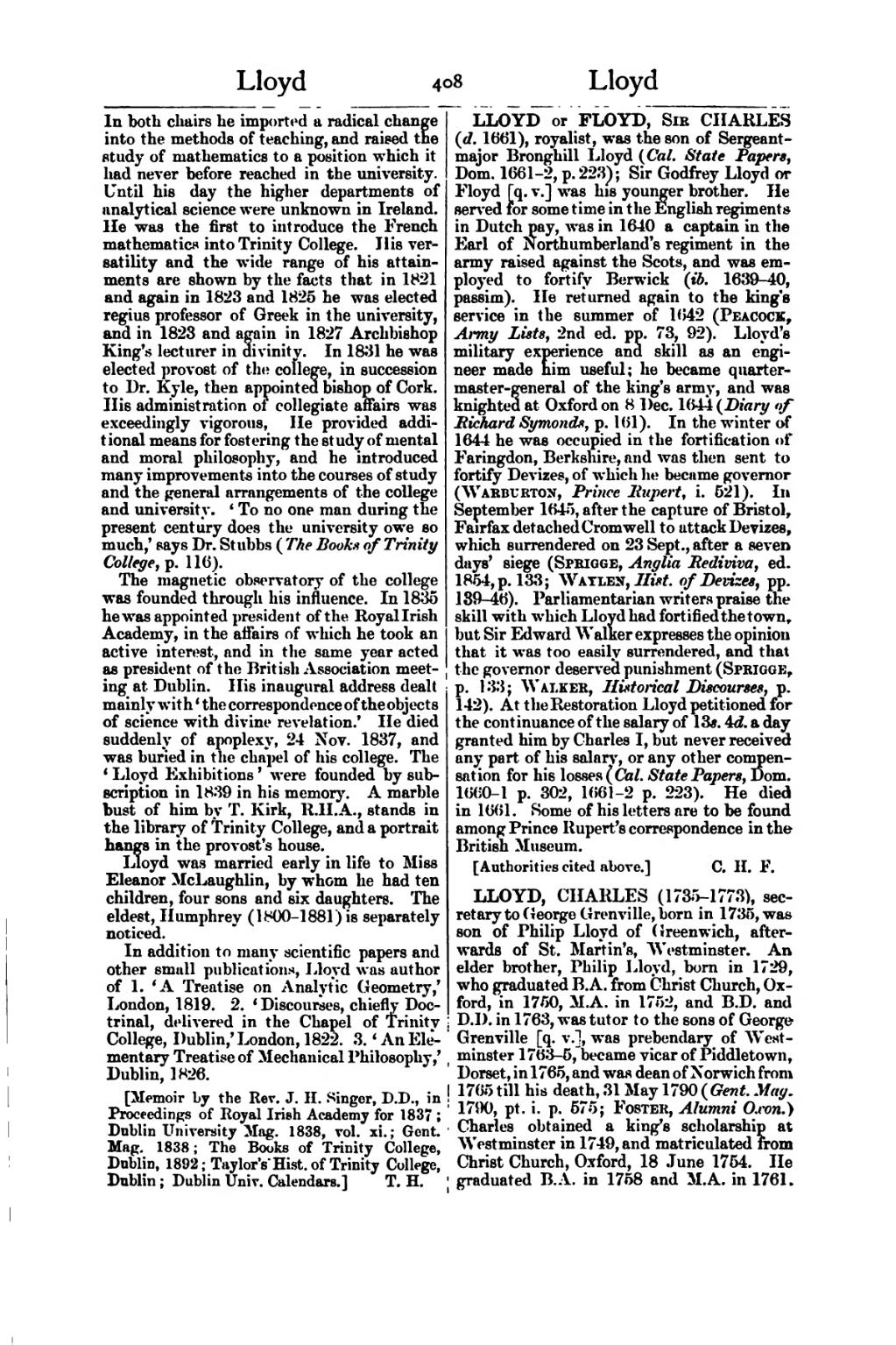In both chairs he imported a radical change into the methods of teaching, and raised the study of mathematics to a position which it had never before reached in the university. Until his day the higher departments of analytical science were unknown in Ireland. He was the first to introduce the French mathematics into Trinity College. His versatility and the wide range of his attainments are shown by the facts that in 1821 and again in 1823 and 1825 he was elected regius professor of Greek in the university, and in 1823 and again in 1827 Archbishop King's lecturer in divinity. In 1831 he was elected provost of the college, in succession to Dr. Kyle, then appointed bishop of Cork. His administration of collegiate affairs was exceedingly vigorous. He provided additional means for fostering the study of mental and moral philosophy, and he introduced many improvements into the courses of study and the general arrangements of the college and university. ‘To no one man during the present century does the university owe so much,’ says Dr. Stubbs (The Books of Trinity College, p. 116).
The magnetic observatory of the college was founded through his influence. In 1835 he was appointed president of the Royal Irish Academy, in the affairs of which he took an active interest, and in the same year acted as president of the British Association meeting at Dublin. His inaugural address dealt mainly with ‘the correspondence of the objects of science with divine revelation.’ He died suddenly of apoplexy, 24 Nov. 1837, and was buried in the chapel of his college. The ‘Lloyd Exhibitions’ were founded by subscription in 1839 in his memory. A marble bust of him by T. Kirk, R.H.A., stands in the library of Trinity College, and a portrait hangs in the provost's house.
Lloyd was married early in life to Miss Eleanor McLaughlin, by whom he had ten children, four sons and six daughters. The eldest, Humphrey (1800–1881) is separately noticed.
In addition to many scientific papers and other small publications, Lloyd was author of 1. ‘A Treatise on Analytic Geometry,’ London, 1819. 2. ‘Discourses, chiefly Doctrinal, delivered in the Chapel of Trinity College, Dublin,’ London, 1822. 3. ‘An Elementary Treatise of Mechanical Philosophy,’ Dublin, 1826.
[Memoir by the Rev. J. H. Singer, D.D., in Proceedings of Royal Irish Academy for 1837; Dublin University Mag. 1838, vol. xi.; Gent. Mag. 1838; The Books of Trinity College, Dublin, 1892; Taylor's Hist. of Trinity College, Dublin; Dublin Univ. Calendars.]
LLOYD or FLOYD, Sir CHARLES (d. 1661), royalist, was the son of Sergeant-major Brochwel Lloyd (Cal. State Papers, Dom. 1661–2, p. 223); Sir Godfrey Lloyd or Floyd [q. v.] was his younger brother. He served for some time in the English regiments in Dutch pay, was in 1640 a captain in the Earl of Northumberland's regiment in the army raised against the Scots, and was employed to fortify Berwick (ib. 1639–40, passim). He returned again to the king's service in the summer of 1642 (Peacock, Army Lists, 2nd ed. pp. 73, 92). Lloyd's military experience and skill as an engineer made him useful; he became quartermaster-general of the king's army, and was knighted at Oxford on 8 Dec. 1644 (Diary of Richard Symonds, p. 161). In the winter of 1644 he was occupied in the fortification of Faringdon, Berkshire, and was then sent to fortify Devizes, of which he became governor (Warburton, Prince Rupert, i. 521). In September 1645, after the capture of Bristol, Fairfax detached Cromwell to attack Devizes, which surrendered on 23 Sept., after a seven days' siege (Sprigge, Anglia Rediviva, ed. 1854, p. 133; Waylen, Hist. of Devizes, pp. 139–46). Parliamentarian writers praise the skill with which Lloyd had fortified the town, but Sir Edward Walker expresses the opinion that it was too easily surrendered, and that the governor deserved punishment (Sprigge, p. 133; Walker, Historical Discourses, p. 142). At the Restoration Lloyd petitioned for the continuance of the salary of 13s. 4d. a day granted him by Charles I, but never received any part of his salary, or any other compensation for his losses (Cal. State Papers, Dom. 1660–1 p. 302, 1661–2 p. 223). He died in 1661. Some of his letters are to be found among Prince Rupert's correspondence in the British Museum.
[Authorities cited above.]
LLOYD, CHARLES (1735–1773), secretary to George Grenville, born in 1735, was son of Philip Lloyd of Greenwich, afterwards of St. Martin's, Westminster. An elder brother, Philip Lloyd, born in 1729, who graduated B.A. from Christ Church, Oxford, in 1750, M.A. in 1752, and B.D. and D.D. in 1763, was tutor to the sons of George Grenville [q. v.], was prebendary of Westminster 1763–5, became vicar of Piddletown, Dorset, in 1765, and was dean of Norwich from 1765 till his death, 31 May 1790 (Gent. Mag. 1790, pt. i. p. 575; Foster, Alumni Oxon.) Charles obtained a king's scholarship at Westminster in 1749, and matriculated from Christ Church, Oxford, 18 June 1754. He graduated B.A. in 1758 and M.A. in 1761.
